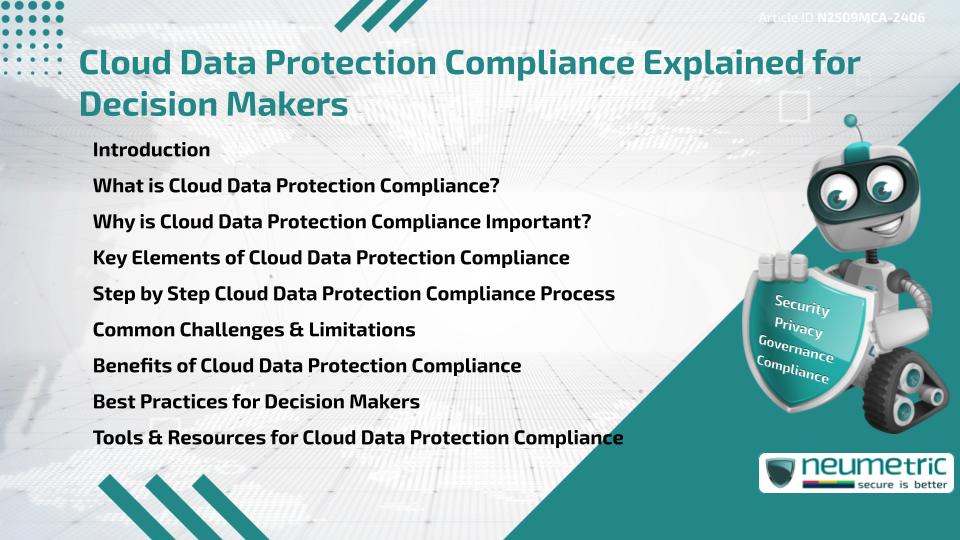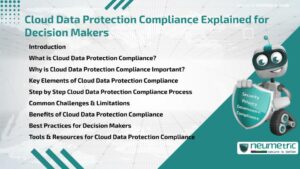Table of Contents
ToggleIntroduction
Cloud Data Protection Compliance explained for decision makers is vital in today’s environment where Sensitive Data is increasingly stored & processed in the cloud. Compliance ensures that organisations meet Legal, Regulatory & Contractual obligations while maintaining data Confidentiality, Integrity & Availability. This article explains what cloud Data Protection Compliance is, why it matters, its core elements & the step by step process to achieve it. It also highlights challenges, benefits & Best Practices tailored for decision makers.
What is Cloud Data Protection Compliance?
Cloud Data Protection Compliance refers to the Policies, Procedures & Technical Measures that ensure Cloud-based data handling aligns with Legal & Regulatory requirements. It covers Compliance with frameworks such as GDPR, HIPAA & ISO 27001 & focuses on securing Sensitive Data in Cloud environments across storage, processing & transmission.
Why is Cloud Data Protection Compliance Important?
The importance of Compliance lies in its ability to:
- Safeguard Sensitive Data against breaches & unauthorised access
- Meet Regulatory requirements across jurisdictions
- Build Trust with Clients, Regulators & Stakeholders
- Reduce Financial & Reputational Risks
- Enable secure adoption of Cloud technologies
Key Elements of Cloud Data Protection Compliance
Core elements include:
- Data Classification – Identifying & categorising Sensitive Data
- Access Management – Enforcing Least Privilege & Identity verification
- Encryption & Masking – Protecting data in transit & at rest
- Vendor Management – Ensuring Cloud Service Providers meet Compliance obligations
- Monitoring & Auditing – Tracking Compliance & Security Performance
Step by Step Cloud Data Protection Compliance Process
Decision makers can follow these steps:
- Define Compliance Scope – Identify applicable regulations & requirements.
- Classify Data – Map & categorise Cloud data assets.
- Assess Risks – Evaluate Threats, Vulnerabilities & Likelihood of Incidents.
- Implement Controls – Apply Encryption, Access management & Monitoring solutions.
- Establish Policies – Develop Cloud Security & Compliance Policies.
- Conduct Training – Ensure Employees understand Compliance responsibilities.
- Monitor & Audit – Review systems regularly for Compliance & Gaps.
- Engage Providers – Verify that Cloud Service Providers meet Contractual & Regulatory Standards.
Common Challenges & Limitations
Organisations face:
- Complexity in multi-cloud & hybrid environments
- Uncertainty about shared responsibility models
- Rapidly evolving Regulatory requirements
- Resource & budget constraints
- Difficulty maintaining consistent monitoring
Benefits of Cloud Data Protection Compliance
Effective Compliance provides:
- Stronger resilience against Cyber Threats
- Legal & Regulatory assurance
- Increased Customer & Partner confidence
- Improved Operational efficiency
- Competitive advantage in the marketplace
Best Practices for Decision Makers
To sustain Compliance:
- Embed Compliance into cloud adoption strategies
- Conduct due diligence on Cloud Service Providers
- Use automation for Compliance monitoring
- Train staff regularly on Cloud Security Policies
- Continuously update frameworks with evolving regulations
Tools & Resources for Cloud Data Protection Compliance
Supporting tools include:
- Cloud Security posture management [CSPM] platforms
- Compliance Monitoring & Audit solutions
- Data Encryption & Key Management tools
- Vendor Risk Management frameworks
Takeaways
- Cloud Data Protection Compliance safeguards Sensitive Data in Cloud environments
- A structured process ensures Regulatory & Security alignment
- Decision makers must address challenges with strategy & resources
- Best Practices improve Compliance, Trust & Business resilience
FAQ
What does cloud Data Protection Compliance mean?
It means aligning cloud data storage, processing & handling with Regulatory & Security standards.
Which regulations are most relevant to cloud Data Protection Compliance?
Regulations such as GDPR, HIPAA, PCI DSS & ISO 27001 are highly relevant.
Who is responsible for cloud Data Protection Compliance?
Both the Organisation & its Cloud Service Providers share responsibility under the shared responsibility model.
How often should cloud Compliance audits be performed?
At least annually or more frequently depending on Regulatory & Contractual obligations.
What are the biggest Risks in cloud Data Protection?
Data breaches, misconfigured cloud settings & insufficient Access Controls are among the top Risks.
Can cloud Data Protection Compliance improve business performance?
Yes, it builds trust, reduces Risk & enables safe cloud adoption, improving overall performance.
What tools support cloud Data Protection Compliance?
CSPM tools, Encryption solutions, Monitoring Software & Compliance frameworks support cloud Compliance.
Need help for Security, Privacy, Governance & VAPT?
Neumetric provides organisations the necessary help to achieve their Cybersecurity, Compliance, Governance, Privacy, Certifications & Pentesting needs.
Organisations & Businesses, specifically those which provide SaaS & AI Solutions in the Fintech, BFSI & other regulated sectors, usually need a Cybersecurity Partner for meeting & maintaining the ongoing Security & Privacy needs & requirements of their Enterprise Clients & Privacy conscious Customers.
SOC 2, ISO 27001, ISO 42001, NIST, HIPAA, HECVAT, EU GDPR are some of the Frameworks that are served by Fusion – a SaaS, multimodular, multitenant, centralised, automated, Cybersecurity & Compliance Management system.
Neumetric also provides Expert Services for technical security which covers VAPT for Web Applications, APIs, iOS & Android Mobile Apps, Security Testing for AWS & other Cloud Environments & Cloud Infrastructure & other similar scopes.
Reach out to us by Email or filling out the Contact Form…





